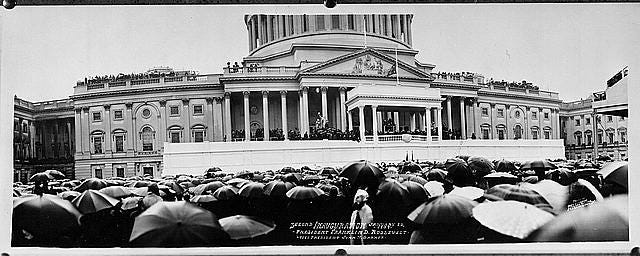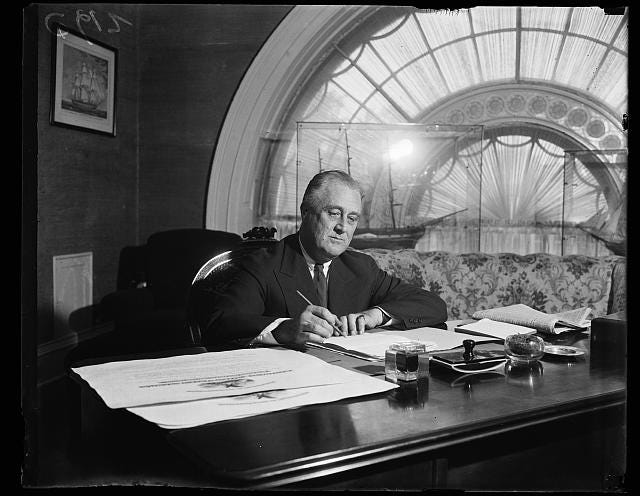WASHINGTON, D.C. — Moments after taking the oath of office in a downpour, President Franklin Roosevelt turned toward Capitol Plaza to deliver his second inaugural address.
My Fellow-Countrymen:
When four years ago we met to inaugurate a president, the republic, single-minded in anxiety, stood in spirit here. We dedicated ourselves to the fulfillment of a vision — to speed the time when there would be for all the people that security and peace essential to the pursuit of happiness. We of the republic pledged ourselves to drive from the temple of our ancient faith those who had profaned it; to end by action, tireless and unafraid, that stagnation and despair of that day.
We did those things first.
The president looked older. His hair was thinning, with more gray. His features were “heavier.” But his physician had pronounced that he was in good health.
FDR said Americans “were writing a new chapter in our book of self-government.” It promoted economic morality in the long run, to help bring about prosperity, security and peace for all. He detected a change in the country that went beyond falling unemployment and rising national income.
“For these reasons,” the president said, “I am justified in believing that the greatest change we have witnessed has been the change in moral climate in America.”
The thousands in the plaza warmed to his words.
“The president’s speech was continuously interrupted with applause,” wrote correspondent Arthur Knock.
However, many people couldn’t hear his words because of the pelting rain and sleet. At the podium, the president paused twice during his address to wipe water from his face.
There was more to do. The country had not fulfilled the vision Roosevelt had cast in his first inaugural address; it had yet to reach “our happy valley.” The president saw a blessed and prosperous nation faced with the challenge of sharing its blessings and prosperity with all the people.
“I see one-third of a nation ill-housed, ill-clad, ill-nourished. It is not in despair that I paint you that picture. I paint for you in hope, because the nation, seeing and understanding the injustice of it, proposes to paint it out.”
He added, “The test of our progress is not whether we add more to the abundance of those who have much, it is whether we provide enough for those who have too little.”
Applause and cheers erupted in the rain.
FDR completed the 2,000-word address.
“I assume the solemn obligation of leading the American people forward along the road over which they have chosen to advance. While this duty rests upon me I shall do my utmost to speak their purpose and to do their will, seeking divine guidance to help us each and every one to give light to them that sit in darkness and to guide our feet into the way of peace.”
The president’s inaugural address would be widely praised, including by Republicans. The full text of the speech was in high demand, and it would be made available to the public in the late and morning editions of the nation’s newspapers.
* * *
In the Ohio River town of Brandenburg, Kentucky, Mama Bondurant and family members gathered to listen to the inauguration on the radio.
“We enjoyed it a lot,” Mama wrote in her diary.
It was warm and rainy in Brandenburg, unlike the “awfully bad day” of cold rain and sleet in the Capitol. Later, Mama and Annie Grinnell went to check the river.
“It’s rising fast — nearly to Henry Allen’s store,” she wrote.
* * *
It was about 1 p.m. at the Capitol.
The president settled into the back seat of an open car for the return trip to the White House. He had insisted on an open car to expose himself to the same weather conditions as the people lining Pennsylvania Avenue. He removed his silk top hat and waved it overhead along the route.
The first lady was by his side for the 15-minute ride. Upon their return to the White House at 1:20 p.m., she and her husband changed out of their soaked clothes. Mrs. Roosevelt’s dress, hat and fur coat were in ruins.
“FDR looked as though he had fallen into a swimming pool with his clothes on,” wrote biographer Jean Edward Smith.
The Roosevelts hosted a buffet luncheon for 600 guests that included the president’s cabinet, governors and members of Congressional and Inaugural committees.
At 2:30 p.m. the president, first lady and their guests moved to a special platform in front of the White House for the Inaugural Parade, which began at Capitol Plaza and moved along Pennsylvania Avenue.
The parade showcased the U.S. military, including army cadets from West Point and midshipmen from nearby Annapolis.
As the commander-in-chief, FDR reviewed the parade, again exposed to the storm because he had ordered that a glass shield be removed from the viewing platform. The president returned salutes from marchers, and each time the colors passed, he took off his hat.
At 4 p.m. the president and first lady hosted a tea party for 3,000 guests. Later they dined with family.
At 8:50 p.m. the first lady, joined by Mrs. Woodrow Wilson as her guest of honor, attended a concert at Constitutional Hall. It was the final activity of a long day. Her husband stayed at the White House and retired at 10:30 p.m.
The president had survived four difficult years in the Oval Office. During this day’s inauguration and inaugural parade — the first held in January — a smiling FDR stood on crippled legs in a storm.
The test of his endurance was far from over.
Thank you for reading. If you liked this installment, please click the 🤍. Access the archives for the full chronology of The 1937 Flood Journal.





Great interweaving of these two events and stories.